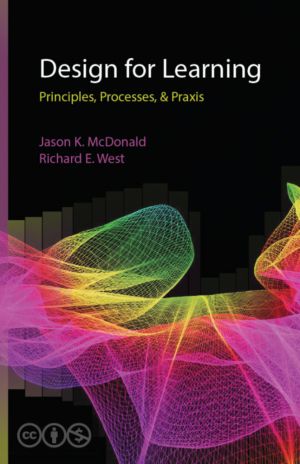Design for Learning
Principles, Processes, and Praxis
by Jason McDonald, Richard West
DescriptionTable of ContentsDetailsHashtagsReport an issue
Our second purpose complements the first: to introduce instructional designers to some of the most current views on how the practices of design thinking contribute towards the development of effective and engaging learning environments. While some previous books have incorporated elements of design thinking (for example, processes like prototyping), to date no instructional design textbook focuses on design-oriented thinking as the dominant approach for creating innovative learning systems. Our aim is to provide resources to faculty and students for learning instructional design in a manner consistent with a design-oriented worldview. But because the classic approaches to instructional design are still important for many professionals, we also include chapters that introduce some of the traditional, systematic processes for designing instructional environments. We hope this blend of traditional and innovative views provides readers with a competitive advantage in their own work, providing them with a larger set of conceptual tools to draw on as they address the professional challenges they face. 






Book Description
Our purpose in this book is twofold. First, we introduce the basic skill set and knowledge base used by practicing instructional designers. We do this through chapters contributed by experts in the field who have either academic, research-based backgrounds, or practical, on-the-job experience (or both). Our goal is that students in introductory instructional design courses will be able to use this book as a guide for completing a basic instructional design project. We also hope the book is useful as a ready resource for more advanced students or others seeking to develop their instructional design knowledge and skills.Our second purpose complements the first: to introduce instructional designers to some of the most current views on how the practices of design thinking contribute towards the development of effective and engaging learning environments. While some previous books have incorporated elements of design thinking (for example, processes like prototyping), to date no instructional design textbook focuses on design-oriented thinking as the dominant approach for creating innovative learning systems. Our aim is to provide resources to faculty and students for learning instructional design in a manner consistent with a design-oriented worldview. But because the classic approaches to instructional design are still important for many professionals, we also include chapters that introduce some of the traditional, systematic processes for designing instructional environments. We hope this blend of traditional and innovative views provides readers with a competitive advantage in their own work, providing them with a larger set of conceptual tools to draw on as they address the professional challenges they face.
This open book is licensed under a Creative Commons License (CC BY-NC). You can download Design for Learning ebook for free in PDF format (21.6 MB).
Table of Contents
Part I
Instructional Design Practice
Chapter 1
Becoming a Learning Designer
Chapter 2
Designing for Diverse Learners
Chapter 3
Conducting Research for Design
Chapter 4
Determining Environmental and Contextual Needs
Chapter 5
Conducting a Learner Analysis
Chapter 6
Problem Framing
Chapter 7
Task and Content Analysis
Chapter 8
Documenting Instructional Design Decisions
Chapter 9
Generating Ideas
Chapter 10
Instructional Strategies
Chapter 11
Instructional Design Prototyping Strategies
Chapter 12
Design Critique
Chapter 13
The Role of Design Judgment and Reflection in Instructional Design
Chapter 14
Instructional Design Evaluation
Chapter 15
Continuous Improvement of Instructional Materials
Part II
Instructional Design Knowledge
Chapter 16
Learning Theories
Chapter 18
Making Good Design Judgments via the Instructional Theory Framework
Chapter 19
The Nature and Use of Precedent in Designing
Chapter 20
Standards and Competencies for Instructional Design and Technology Professionals
Chapter 21
Design Thinking
Chapter 22
Robert Gagne and the Systematic Design of Instruction
Chapter 23
Designing Instruction for Complex Learning
Chapter 24
Curriculum Design Processes
Chapter 25
Agile Design Processes and Project Management
Chapter 26
Designing Technology-Enhanced Learning Experiences
Chapter 27
Designing Instructional Text
Chapter 28
Audio and Video Production for Instructional Design Professionals
Chapter 29
Using Visual and Graphic Elements While Designing Instructional Activities
Chapter 30
Simulations and Games
Chapter 31
Designing Informal Learning Environments
Chapter 32
The Design of Holistic Learning Environments
Chapter 33
Measuring Student Learning
Chapter 34
Working With Stakeholders and Clients
Chapter 35
Leading Project Teams
Chapter 36
Implementation and Instructional Design
Book Details
Title
Design for Learning
Subject
Engineering and Technology
Publisher
EdTech Books
Published
2021
Pages
684
Edition
1
Language
English
PDF Size
21.6 MB
License

Related Books

GUI Design for Android Apps is the perfect - and concise - introduction for mobile app developers and designers. Through easy-to-follow tutorials, code samples, and case studies, the book shows the must-know principles for user-interface design for Android apps running on the Intel platform, including smartphones, tablets and embedded devices.
T...

This book provides insight into what it takes to actively involve teachers in the curriculum design process. It examines different aspects of teacher involvement in collaborative curriculum design, with specific attention to its implications for sustainable curriculum innovation and teacher learning. Divided into six sections, the book starts out b...

This survey focuses on the main trends in the field of calculus education. Despite their variety, the findings reveal a cornerstone issue that is strongly linked to the formalism of calculus concepts and to the difficulties it generates in the learning and teaching process. As a complement to the main text, an extended bibliography with some of the...

This book addresses the issue of diffusing sustainable energy access inlow- and middle-income contexts.
Access to energy is one of the greatest challenges for many people living in low-income and developing contexts, as around 1.4 billion people lack access to electricity.Distributed Renewable Energy systems (DRE) are considered a promising approa...

This book deals with the relevance of recognition and validation of non-formal and informal learning in education and training, the workplace and society. In an increasing number of countries, it is at the top of the policy and research agenda ranking among the possible ways to redress the glaring lack of relevant academic and vocational qualificat...

This ICME-13 Topical Survey reviews the state-of-the-art by first exploring the roots and scope of design science. Second, it presents two examples of current design science projects that focus on substantial learning environments including a student and a teacher perspective. Subsequently, the book elaborates on how empirical research can be conce...

